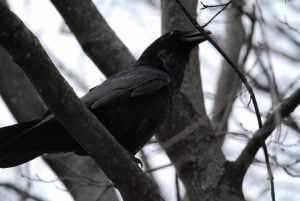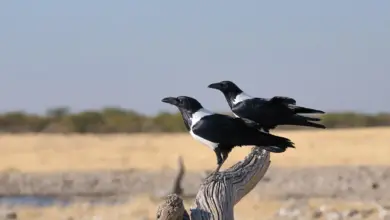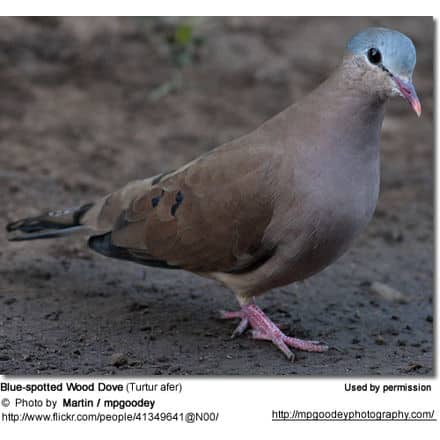Common Raven
Common Raven (Corvus corax)
Crow Information … Raven Information Page … Photos of Raven Species for Identification
The Common Ravens (Corvus corax), also known as the Northern Raven, is a large, all-black passerine bird in the crow family. Found across the northern hemisphere, it is the most widely distributed of all corvids. There are eight known subspecies with little variation in appearance—although recent research has demonstrated significant genetic differences among populations from various regions. It is one of the two largest corvids, alongside the Thick-billed Raven, and is possibly the heaviest passerine bird; at maturity, the Common Raven is between 56 and 69 cm (22 to 27 inches) in length, with recorded weights ranging from 0.69 to 1.63 kg (1.5 to 3.6 pounds). Common Ravens typically live about 10 to 15 years in the wild, although lifespans of up to 40 years have been recorded. Young birds may travel in flocks, but later mate for life, with each mated pair defending a territory.
The Common Raven has coexisted with humans for thousands of years, and in some areas has been so successful that it is considered a pest. Part of its success comes from its omnivorous diet; Common Ravens are extremely versatile and opportunistic in finding sources of nutrition, feeding on carrion, insects and food waste, in addition to cereal grains, berries, fruit and small animals.
Some remarkable feats of problem-solving have been observed in the species, leading to the belief that it is highly intelligent. Over the centuries, it has been the subject of mythology, folklore, art and literature. In many indigenous cultures, including those of Scandinavia, ancient Ireland and Wales, Bhutan, the northwest coast of North America, Siberia and northeast Asia, the Common Raven has been revered as a spiritual figure or god.
Classification
The closest relatives of the Common Raven are the Brown-necked Raven (C. ruficollis) and the Pied Crow (C. albus) of Africa, and the Chihuahuan Raven (C. cryptoleucus) of the North American southwest. There are eight recognized subspecies:
- C. c. corax (the nominate subspecies) occurs from Europe eastwards to Lake Baikal, south to the Caucasus region and northern Iran. It has a relatively short, arched bill.
- C. c. varius occurs in Iceland and the Faroe Islands. It is less glossy than C. c. principalis or nominate corax, is intermediate in size, and the bases of its neck feathers are whitish (not visible at a distance). An extinct color morph (genetic mutation) found only on the Faroes is known as Pied Raven
- C. c. subcorax occurs from Greece eastwards to north-west India, Central Asia and western China though not the Himalayan region. It is larger than the nominate form, but has relatively short throat feathers (hackles). Its plumage is generally all black, though its neck and breast have a brownish tone similar to that of the Brown-necked Raven; this more evident when the plumage is worn. The bases of its neck feathers, although somewhat variable in colour, are often almost whitish.
- C. c. tingitanus occurs in North Africa and the Canary Islands. It is the smallest subspecies, with the shortest throat hackles and a distinctly oily plumage gloss. Its bill is short but markedly stout, and the culmen is strongly arched. Over time, its plumage fades to dark brown on the head and body.
- C. c. tibetanus occurs in the Himalayas. It is the largest and glossiest subspecies, with the longest throat hackles. Its bill is large but less imposing than that of C. c. principalis, and the bases of its neck feathers are grey.
- C. c. kamtschaticus occurs in north-eastern Asia, intergrading into the nominate subspecies in the Baikal region. It is intermediate in size between C. c. principalis and C. c. corax and has a distinctly larger and thicker bill than does the nominate race.
- C. c. principalis occurs in northern North America and Greenland. It has a large body and the largest bill, its plumage is strongly glossed, and its throat hackles are well developed.
- C. c. sinuatus, the Western Raven, occurs in south-central USA and Central America. It is smaller, with a smaller and narrower bill than C. c. principalis. The Revillagigedo Islands population has been named as subspecies clarionensis but this is not usually accepted.
Description
A mature Common Ravens is between 56 and 69 cm (22 to 27 inches) in length, with a wingspan of 115 to 130 cm (45 to 51 in). Recorded weights range from 0.69 to 1.63 kg (1.5 to 3.6 lb), making it one of the heaviest passerines. Birds from colder regions such as the Himalayas and Greenland are generally larger with slightly larger bills, while those from warmer regions are smaller with proportionally smaller bills. The bill is large and slightly curved. It has a longish, strongly graduated tail, mostly black iridescent plumage, and a dark brown iris. The throat feathers are elongated and pointed and the bases of the neck feathers are pale brownish-grey.
Juvenile plumage is similar but duller with a blue-grey iris.
Apart from its greater size, the Common Raven differs from its cousins, the crows, by having a larger and heavier beak, a shaggy throat, and a wedge-shaped tail. The species has a distinctive, deep, resonant prruk-prruk-prruk call, which to experienced listeners is unlike that of any other corvid. Its very wide and complex vocabulary includes a high, knocking toc-toc-toc, a dry, grating kraa, a low guttural rattle and some calls of an almost musical nature.
Common Ravens can be very long-lived, especially in captive or protected conditions; individuals at the Tower of London have lived for more than 40 years. Lifespans in the wild are considerably shorter: typically only 10 to 15 years. The longest known lifespan of a banded wild Common Raven was 13 years.
Distribution and Habitat
Common Ravens can thrive in varied climates; indeed this species has the largest range of any member of the genus. They range throughout the Holarctic from Arctic and temperate habitats in North America and Eurasia to the deserts of North Africa, and to islands in the Pacific Ocean. In the British Isles, they are more common in Scotland, northern England and the west of Ireland. In Tibet, they have been recorded at altitudes up to 5,000 m (16,400 ft), and as high as 6,350 m (20,600 ft) on Mount Everest.
Except in Arctic habitats, they are generally resident within their range for the whole year. Young birds may disperse locally.
In the Faroe Islands a now extinct colour-morph of this species existed, known as the Pied Raven.
Most Common Ravens prefer wooded areas, with large expanses of open land nearby, or coastal regions for their nesting sites and feeding grounds. In some areas of dense human population, such as California in the United States, they take advantage of a plentiful food supply and have seen a surge in their numbers.
Behavior
Common Ravens usually travel in mated pairs, although young birds may form flocks. Relationships between Common Ravens are often quarrelsome, yet they demonstrate considerable devotion to their families.
Diet
Common Ravens are omnivorous and highly opportunistic: their diet may vary widely with location, season and serendipity. For example, those foraging on tundra on the Arctic North Slope of Alaska obtained about half their energy needs from predation, mainly of microtine rodents, and half by scavenging, mainly of caribou and ptarmigan carcasses.
In some places they are mainly scavengers, feeding on carrion as well as the associated maggots and carrion beetles. Plant food includes cereal grains, berries and fruit. They prey on small invertebrates, amphibians, reptiles, small mammals and birds. Ravens may also consume the undigested portions of animal feces, and human food waste. They store surplus food items, especially those containing fat, and will learn to hide such food out of the sight of other Common Ravens. They also raid the food caches of other species, such as the Arctic Fox. They may also associate with another canine, the Grey Wolf, as a kleptoparasite, following to scavenge carcasses in winter.
Common Ravens nesting near sources of human garbage included a higher percentage of food waste in their diet, birds nesting near roads consumed more road-killed vertebrates, and those nesting far from these sources of food ate more arthropods and plant material. Fledging success was higher for those using human garbage as a food source. In contrast, a 1984-1986 study of Common Raven diet in south-western Idaho, an agricultural region, found that cereal grains were the principal constituent of pellets, though small mammals, grasshoppers, cattle carrion and birds were also eaten.
One behavior used by young birds is recruitment, where dominant juvenile ravens call other ravens to a food bonanza, usually a carcass, with a series of loud yells. In Ravens in Winter, Bernd Heinrich posited that this behavior evolved to allow the juveniles to outnumber the resident adults, thus allowing them to feed on the carcass without being chased away. A more mundane explanation is that individuals co-operate in sharing information about carcasses of large mammals because they are too big for just a few birds to eat.
Breeding
Juveniles begin to court at a very early age, but may not bond for another two or three years.
Aerial acrobatics and demonstrations of intelligence, and ability to provide food are key behaviors of courting. Once paired, they tend to nest together for life, usually in the same location. Sexual infidelity has been observed in Common Ravens, by males visiting a female’s nest when her mate is away.
Breeding pairs must have a territory of their own before they begin nest-building and reproduction, and thus aggressively defend a territory and its food resources.
Nesting territories vary in size according to the density of food resources in the area. The nest is a deep bowl made of large sticks and twigs, bound with an inner layer of roots, mud, and bark and lined with a softer material, such as deer fur. The nest is usually placed in a large tree or on a cliff ledge, or less frequently in old buildings or utility poles.
Females lay between three to seven pale bluish-green, brown-blotched eggs. Incubation is about 18 to 21 days, by the female only. However, the male may stand or crouch over the young, sheltering but not actually brooding them. Young fledge at 35 to 42 days, and are fed by both parents. They stay with their parents for another six months after fledging.
In most of their range, egg laying begins in late February. In colder climates, it is later, e.g. April in Greenland and Tibet. In Pakistan, egg-laying takes place in December. Eggs and hatchlings are rarely preyed on by large hawks and eagles, large owls, martens and canids. The adults, with no known natural predators, are often successful in defending their young from these predators, due to their numbers, large size and cunning. They have been observed dropping stones on potential predators that venture close to their nests.
Vocalization
Like other corvids, Ravens can mimic sounds from their environment, including human speech. They have a wide range of vocalizations, which remain an object of interest to ornithologists. Gwinner carried out important studies in the early 1960s, recording and photographing his findings in great detail.
Fifteen to 30 categories of vocalization have been recorded for this species, most of which are used for social interaction. Calls recorded include alarm calls, chase calls, and flight calls. Non-vocal sounds produced by the Common Raven include wing whistles and bill snapping. Clapping or clicking has been observed more often in females than in males. If a member of a pair is lost, its mate reproduces the calls of its lost partner to encourage its return.
Intelligence
Common Ravens have among the largest brains of any bird species. Specifically, their hyperpallium (part of a bird’s brain) is large. For an avian, they display ability in problem solving, as well as other cognitive processes such as imitation and insight.
One experiment designed to evaluate insight and problem-solving ability involved a piece of meat attached to a string hanging from a perch. To reach the food, the bird needed to stand on the perch, pull the string up a little at a time, and step on the loops to gradually shorten the string. Four of five Common Ravens eventually succeeded, and “the transition from no success (ignoring the food or merely yanking at the string) to constant reliable access (pulling up the meat) occurred with no demonstrable trial-and-error learning”.
Common Ravens have been observed to manipulate others into doing work for them, such as by calling wolves and coyotes to the site of dead animals. The canines open the carcass, making it more accessible to the birds. They watch where other Common Ravens bury their food and remember the locations of each other’s food caches, so they can steal from them. This type of theft occurs so regularly that Common Ravens will fly extra distances from a food source to find better hiding places for food. They have also been observed pretending to make a cache without actually depositing the food, presumably to confuse onlookers.
Common Ravens are known to steal and cache shiny objects such as pebbles, pieces of metal, and golf balls. One theory is that they hoard shiny objects to impress other ravens. Other research indicates that juveniles are deeply curious about all new things, and that Common Ravens retain an attraction to bright, round objects based on their similarity to bird eggs. Mature birds lose their intense interest in the unusual, and become highly neophobic.
In recent years, biologists have begun to recognize that birds engage in play. Juvenile Common Ravens are among the most playful of bird species. They have been observed to slide down snowbanks, apparently purely for fun. They even engage in games with other species, such as playing catch-me-if-you-can with wolves and dogs. Common Ravens are known for spectacular acrobatic displays, such as flying in loops.
Relationship with humans
Conservation and management
Common Ravens are widely distributed and are not in danger of extinction. In some parts of their range, there have been localised declines due to habitat loss and direct persecution. In other areas, their numbers have increased dramatically and they have become agricultural pests. Common Ravens can cause damage to crops, such as nuts and grain, or can harm livestock, particularly by killing young goat kids, lambs and calves. Ravens generally attack the faces of young livestock, but the more common Raven behavior of scavenging may be misidentified as predation by ranchers.
In the western Mojave desert, human settlement and land development have led to an estimated 16-fold increase in the Common Raven population over 25 years. Towns, landfills, sewage treatment plants and artificial ponds create sources of food and water for scavenging birds. Ravens also find nesting sites in utility poles and ornamental trees, and are attracted to roadkill on highways. The explosion in the Common Raven population in the Mojave has raised concerns for the desert tortoise, a threatened species. Common Ravens prey upon juvenile tortoises, which have soft shells and are slow-moving. Plans to control the population have included shooting and trapping birds, as well as contacting landfill operators to ask that they reduce the amount of exposed garbage. A hunting bounty as a method of control was historically used in Finland from the mid-18th century until 1923. Culling has taken place to a limited extent in Alaska, where the population increase in Common Ravens is threatening the vulnerable Steller’s Eider (Polysticta stelleri).
Cultural depictions
Across its range in the northern hemisphere, and throughout human history, the Common Raven has been a powerful symbol and a popular subject of mythology and folklore.
In many post-conversion Western traditions, ravens have long been considered to be birds of ill omen, in part because of the negative symbolism of their all-black plumage and eating of carrion. In Sweden, ravens are known as the ghosts of murdered people, and in Germany as the souls of the damned In Danish folklore, a Valravn that ate a king’s heart gained human knowledge, could perform great malicious acts, could lead people astray, had superhuman powers, and were “terrible animals”.
As in traditional mythology and folklore, the Common Raven features frequently in more modern writings such as the works of William Shakespeare, and, perhaps most famously, in the poem “The Raven” by Edgar Allan Poe. Ravens have appeared in the works of Charles Dickens, J. R. R. Tolkien, Stephen King, and Joan Aiken among others.
It continues to be used as a symbol in areas where it once had mythological status: as the National Bird of Bhutan, Official Bird of the Yukon territory, on the Coat of Arms of the Isle of Man (once a Viking colony), and even as the emblem of the Ravens, the American football team of Baltimore (Poe’s hometown).
Mythology
Many indigenous peoples of the Pacific Northwest Coast of North America and northeast Asia revered it as a god. In Tlingit and Haida cultures, Raven was both a Trickster and Creator god. Related beliefs are widespread among the peoples of Siberia and northeast Asia. The Kamchatka peninsula, for example, was supposed to have been created by the raven god Kutkh.
The Norsemen believed that ravens Hugin and Munin sat on the god Odin’s shoulders and saw and heard all, and a Raven banner standard was carried by such Viking figures as the Norse Jarls of Orkney, King Canute the Great of England, Norway and Denmark, and Harald Hardrada. There are several references to Common Ravens in the Old Testament of the Bible and it is an aspect of Mahakala in Bhutanese mythology.
In the British Isles, ravens also were symbolic to the Celts. In Irish mythology, the goddess Morrígan alighted on the hero Cú Chulainn’s shoulder in the form of a raven after his death.
In Welsh mythology they were associated with the Welsh god Bran the Blessed, whose name translates to “raven.” According to the Mabinogion, Bran’s head was buried in the White Hill of London as a talisman against invasion.
A legend developed that England would not fall to a foreign invader so long as there were ravens at the Tower of London; although this is often thought to be an ancient belief, the official Tower of London historian, Geoff Parnell, believes that this is actually a romantic Victorian invention. In fact, the Tower has lacked ravens for long periods in the past; they were last reintroduced after World War II. The government now maintains several birds on the grounds of the Tower. These birds have the primary feathers of one wing clipped periodically to ensure that they cannot leave, though they are free to roam the tower grounds. (Compare the legend of the king in the mountain.)
Taxonomy
The Common Raven was one of the many species originally described by Linnaeus in his 18th century work, Systema Naturae, and it still bears its original name of Corvus corax. It is the type species of the genus Corvus, derived from the Latin for “Raven”.> The specific epithet, corax/?????, is the Ancient Greek word for “raven” or “crow”. The name “raven” has been applied to several other (generally large) species of the genus Corvus, though they are not necessarily closely related to Corvus corax. Some, such as the Australian Raven and Forest Raven, are clearly closer to the other Australian crows. The original raven is now called the Common or Northern Raven.
The word “raven” is similar in many old Germanic languages; the Old English word for a raven was hræfn; in Old Norse it was hrafn or Hrafn, a personal name, and Old High German (h)raban, all these words are descended from a Proto-Germanic *khrabanas. An old Scottish word corby or corbie, akin to the French corbeau, has been used for both this bird and the Carrion Crow. Archaic collective nouns for a group of ravens (or at least the Common Raven) include “unkindness” and “conspiracy”. In practice, most people use the more generic term “flock”.
Evolutionary history
The Common Raven evolved in the Old World and crossed the Bering land bridge into North America. Recent genetic studies,
which examined the DNA of Common Ravens from across the world, have determined that the birds fall into at least two clades: a California clade, found only in the southwestern United States, and a Holarctic clade, found across the rest of the northern hemisphere. Birds from both clades look alike, but the groups are genetically distinct and began to diverge about two million years ago.
The findings indicate that based on mitochondrial DNA, Common Ravens from the rest of the United States are more closely related to those in Europe and Asia than to those in the California clade, and that Common Ravens in the California clade are more closely related to the Chihuahuan Raven (C. cryptoleucus) than to those in the Holarctic clade. Ravens in the Holarctic clade are more closely related to the Pied Crow (C. albus) than they are to the California clade. Thus, the Common Raven species as traditionally delimited is considered to be paraphyletic.
One explanation for these surprising genetic findings is that Common Ravens settled in California at least two million years ago and became separated from their relatives in Europe and Asia during an ice age. One million years ago, a group from the California clade evolved into a new species, the Chihuahuan Raven. Other members of the Holarctic clade arrived later in a separate migration from Asia, perhaps at the same time as humans.
A recent study of raven mitochondrial DNA showed that members of the C. c. tingitanus subspecies have significant genetic differences from the rest of the Holarctic clade. This subspecies occurs only in North Africa and the Canary Islands. The study also demonstrated that C. c. tingitanus ravens do not interbreed with other subspecies.
A taxonomic solution would be to consider at least sinuatus a distinct species again. In fact, it is in many aspects intermediate between the Common Raven proper and the Chihuahuan Raven and was considered distinct enough to warrant a common name of its own, Western Raven, in the early 20th century. Whether the Western Raven ought to be united with the Chihuahuan Raven could be resolved by studies of gene flow and ecological displacement. It is notable that the Brown-necked Raven and Dwarf Ravens of Africa seem to be offshoots of the Common Raven-Pied Crow complex that evolved in parallel in many (mainly ecological) aspects to the Western and Chihuahuan Ravens. Thus, no matter what the eventual taxonomic treatment will be, the Common Raven (and to a lesser degree, Pied Crow) ancestral stock had a tendency to expand into more arid and (sub)tropical climates from humid and temperate regions, producing distinct lineages. Considering the distinctness of tingitanus, such a parallel evolution of ravens adapted to Mediterranean climates has happened four times from the time when the ancestors of Common Ravens and Pied Crows had not yet fully diverged until today.
Copyright: Wikipedia. This article is licensed under the GNU Free Documentation License. It uses material from Wikipedia.org … Additional information and photos added by Avianweb.
Please Note: The articles or images on this page are the sole property of the authors or photographers. Please contact them directly with respect to any copyright or licensing questions. Thank you.






